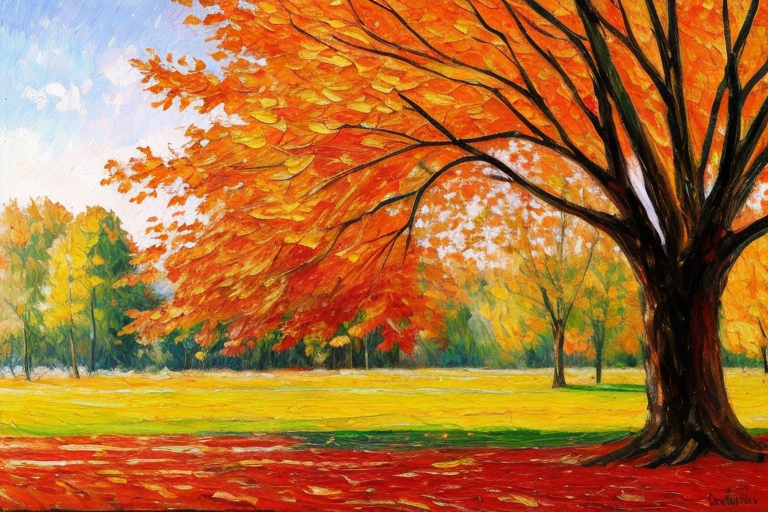The Beauty and Science of Autumnal Foliage
Every year, as summer fades into fall, the leaves on trees begin to change color, creating a stunning display of red, orange, and yellow hues. This natural phenomenon is a sight to behold and draws people from all over the world to witness the beauty of autumnal foliage. But what exactly happens to the leaves during this time, and why do they change color?
The aim of this article is to explore the science behind the changing of leaves in the fall. In the following sections, we will discuss the chemical processes that occur within the leaves, the role of temperature and sunlight, and the significance of this natural wonder.
When leaves change color in the fall, it is because of a process called senescence. This is a natural aging process that occurs in all living things, including plants. As the days get shorter and the temperatures begin to drop, the leaves stop producing chlorophyll, the green pigment that is responsible for photosynthesis. Without chlorophyll, the other pigments in the leaves become more visible, giving them their vibrant fall colors.
The chemistry behind the changing of leaves is fascinating. The pigments responsible for the red and purple colors are called anthocyanins, while the yellow and orange colors come from carotenoids. These pigments are always present in the leaves, but they are usually masked by the chlorophyll. As the chlorophyll breaks down, the other pigments become more visible, creating the beautiful colors of fall.
While the chemical processes that occur within the leaves are fascinating, the changing of colors is also influenced by external factors such as temperature and sunlight. Cooler temperatures cause the leaves to produce more sugars, which in turn produce more anthocyanins. This is why trees at higher elevations or in cooler climates often have more vibrant fall colors.
Sunlight also plays a role in the changing of leaves. Shorter days mean less sunlight, which triggers the senescence process in the leaves. However, too much sunlight can also have a negative effect on fall foliage. Trees that are exposed to too much sunlight may have leaves that dry out and fall off before they have a chance to change color.
Despite the scientific explanation behind the changing of leaves, the significance of autumnal foliage goes beyond just the chemical processes. For many people, the changing of leaves is a symbol of the changing of seasons and a reminder of the beauty of nature. It is a time to reflect on the passing of time and the cyclical nature of life.
The Science Behind Fall Foliage
Have you ever wondered why leaves change color during fall? It’s a beautiful sight to see, but what’s the reason behind it? The answer lies in the chemistry of the leaves.
Each leaf contains pigments that give it its color. Chlorophyll, the pigment responsible for the green color of leaves, is the most abundant pigment. During the summer, chlorophyll is continuously produced, and it masks the other pigments present in the leaf. However, as fall approaches, the days get shorter, and the temperature drops, causing the chlorophyll production to slow down and eventually stop.
As the chlorophyll breaks down, the other pigments present in the leaf become visible. Carotenoids, which produce yellow, orange, and brown colors, are the second most abundant pigments in leaves. They are always present in the leaf, but the green chlorophyll masks them during the summer. When the chlorophyll breaks down, the carotenoids become visible, giving the leaves their warm autumnal hues.
Another pigment present in leaves is anthocyanin, which produces red and purple colors. Unlike carotenoids, anthocyanins are not always present in the leaf. Instead, they are produced in response to environmental stress, such as low temperatures or drought. When the chlorophyll breaks down, the anthocyanins are produced, giving some leaves their vibrant red and purple colors.
Temperature and sunlight also play a crucial role in the process of leaves changing color. Temperature affects the rate at which the chlorophyll breaks down, while sunlight affects the production of anthocyanins. In areas with warm days and cool nights, the colors of the leaves are more vibrant because the chlorophyll breaks down slowly, allowing the other pigments to become visible. In contrast, in areas with warm days and warm nights, the colors of the leaves are less vibrant because the chlorophyll breaks down quickly.
The Science Behind Fall Foliage
As the days grow shorter and the temperatures cool, the leaves on trees begin to change color. While the process may seem magical, there is a scientific explanation behind it. In this section, we will explore the role of temperature and sunlight in the process of leaves changing color.
Temperature plays a significant role in the process of leaves changing color. As the days grow shorter and the temperatures cool, the leaves stop producing chlorophyll, the pigment that gives leaves their green color. This allows other pigments, such as carotenoids and anthocyanins, to become more visible, resulting in the vibrant reds, oranges, and yellows we associate with fall foliage.
Sunlight also plays a crucial role in the process of leaves changing color. Trees in areas with more sunlight tend to have more vibrant fall foliage. This is because sunlight triggers the production of anthocyanins, the pigment responsible for the red and purple colors in leaves. Trees in areas with less sunlight tend to have more yellow and orange leaves, as these colors are produced by carotenoids, which are present in leaves all year round.
Different climates also impact the colors of fall foliage. In areas with warmer climates, the leaves may not change color at all, or they may turn brown and fall off the tree without changing color. In areas with cooler climates, the colors may be more vibrant and last longer. In areas with a mix of warm and cool temperatures, the colors may be more varied, with some trees changing color earlier than others.
The changing colors of fall foliage are not just a beautiful sight; they also play an essential role in the environment. As the leaves change color and fall off the trees, they provide nutrients for the soil, which helps to nourish the trees and other plants in the area. This process also helps to regulate the temperature and moisture levels in the soil, which is crucial for the health of the ecosystem.
The Cultural Significance of Autumnal Foliage
Autumnal foliage is not just a natural phenomenon; it is a cultural event. Every year, people from all over the world flock to areas with vibrant fall foliage to witness the beauty of nature. In the United States, leaf-peeping is a popular activity, with millions of people traveling to New England, the Appalachian Mountains, and the Great Lakes region to see the changing colors of the leaves.
Frank and his son were among those who went on a leaf-peeping adventure one fall. They drove for hours, taking in the breathtaking scenery and snapping pictures along the way. However, their adventure took an unexpected turn when they were pulled over by a police officer for speeding. The officer noticed that they had a bag of leaves in the car and accused them of stealing them from a public park.
Frank and his son were shocked and confused. They had no idea that taking leaves from a public park was illegal. They explained to the officer that they were just collecting leaves as a souvenir of their trip. However, the officer was not convinced and took them to court.
The judge presiding over the case was a stern man named Uvanni. He listened to both sides of the story and then asked Frank and his son why they thought it was okay to take leaves from a public park. Frank explained that they were not aware that it was illegal and that they were just trying to enjoy the beauty of nature.
The judge was sympathetic to their story and decided to let them off with a warning. He explained to them that taking leaves from a public park was indeed illegal and that they should be more careful in the future. However, he also acknowledged the cultural significance of autumnal foliage and how it brings people together to appreciate the beauty of nature.
This story highlights the cultural significance of autumnal foliage and how it can sometimes lead to unexpected adventures. It also shows how important it is to be aware of the laws and regulations surrounding the collection of leaves and other natural materials.
In addition to its cultural significance, autumnal foliage also plays an important role in the environment. As leaves change color and fall to the ground, they provide nutrients for the soil and help to support the growth of new plants and trees. This process is essential for maintaining a healthy ecosystem and ensuring the survival of many species.
Overall, the significance of autumnal foliage cannot be overstated. It is a natural wonder that brings people together and reminds us of the beauty and fragility of the world around us. Whether you are a leaf-peeper, a nature lover, or just someone who appreciates the beauty of the changing seasons, autumnal foliage is something that should be cherished and celebrated.
The Cultural Significance of Autumnal Foliage
Autumnal foliage is not only a beautiful natural phenomenon, but it also holds significant cultural importance in many parts of the world. From festivals to traditions, people have found unique ways to celebrate the changing colors of leaves.
One such tradition is the Japanese art of “momijigari,” which translates to “red leaf hunting.” This tradition involves visiting areas with beautiful autumn foliage and admiring the scenery. In Japan, autumn is considered a time of reflection and appreciation for the beauty of nature.
Similarly, in Korea, the autumn season is celebrated through the “chuseok” festival, also known as the “Korean Thanksgiving.” During this festival, families gather to pay respects to their ancestors and enjoy traditional foods. The festival is also a time to appreciate the beauty of nature, including the changing colors of leaves.
In the United States, the fall season is celebrated through various festivals, including the “Oktoberfest” in Germany and the “Harvest Festival” in many parts of the country. These festivals often feature autumnal foliage as a central theme, with decorations and activities centered around the changing colors of leaves.
The cultural significance of autumnal foliage extends beyond festivals and traditions. In many parts of the world, the changing colors of leaves are a symbol of the changing seasons and the passage of time. For some, the beauty of autumnal foliage is a reminder to slow down and appreciate the simple things in life.
In addition to its cultural significance, autumnal foliage also plays an important role in the environment. As leaves change color and fall to the ground, they provide nutrients for the soil and contribute to the growth of new plants and trees. This cycle of growth and decay is essential for the health of ecosystems around the world.









